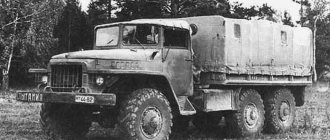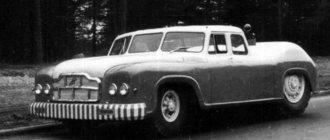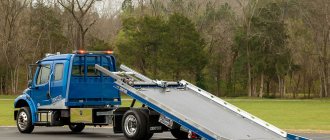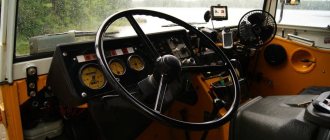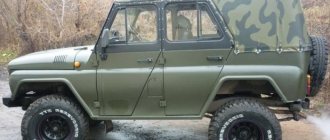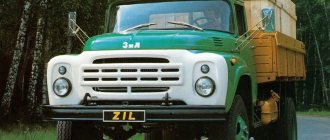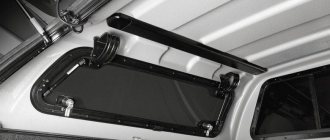History of creation
The Avia 31 brand truck was developed in 1983. It was immediately equipped with an economical yet reliable engine. Due to its ease of operation, high load capacity, and reasonable price, this vehicle has gained popularity in the domestic space.
An equally important factor that influenced the prevalence of the Avia 31 was the manufacturer’s control over the build quality. Optimal adjustment of all systems made it possible to achieve a realistic mileage before major repairs of one hundred and fifty thousand kilometers. In general, it was allowed to carry out such a restoration of the functionality of the car three times during its operation.
"Avia-350": the aircraft's land brother
In the “Autoexotics” section, we have already touched upon the topic of structures built at aviation enterprises. Then we were talking about the Messerschmitt-KR200 car.
But aviators, as you know, have no boundaries either in the sky or on the ground! And the history of the “aircraft creators” is not limited to just the Messerschmitt.
Today we will talk about a very unusual small car built by the Czech Republic. The main activity of the company for a long time was the production of aircraft, but the production of various models of cars brought the company worldwide fame. Until recently, Avia vans were seen in large numbers on the roads of Belarus.
The year of birth of the company, located in the town of Prague-Letnany, was 1919. Its founders were Czech design engineers Pavel Benes and Miloslav Hein.
The guys “rushed” from the start and announced themselves to the world by presenting the BH-1 monoplane fighter. For that time it was a truly revolutionary design, because most aircraft at that time were biplanes.
Before World War II, the plant produced a large number of civil and military aircraft, both of its own design and under license.
In 1928, the company was acquired by the equally famous Czech concern Skoda. And from this time on, the production of not only aviation, but also automobile equipment began. Immediately after the end of the war, Avia produced the Skoda 706P truck and the Skoda 706PO bus.
In 1955, the company's management set the task of creating a small car designed for three people, including the driver, which was supposed to become a kind of folk model for the residents of what was then Czechoslovakia
The engineers' aviation roots were evident primarily in the design and layout of the body. The driver in such a car was placed in the center of a small cabin, and two passengers were placed to the left and right of the driver with a slight ledge.
To get into the salon, there was no need to look for doors - they simply did not exist! Instead, it was enough to move back the entire upper part of the roof with the side pillars, windows and rear window. Just like fighter pilots did to get into the cockpit of an airplane.
The power unit for the model was an air-cooled gasoline engine, well mastered in production and operation. It was a two-stroke motorcycle engine from a Java-350. It was equipped with a manual 4-speed gearbox, to which a reverse gear was added.
The main material used for the manufacture of the monocoque body was lightweight and durable duralumin. It was widely used in aviation; sheets were laid out on special wooden forms. They were specially created for the prototype “Avia-350” (that was the name of the model of the unusual machine). The car was built at an aircraft plant, where at that time Il-14 passenger aircraft were produced under Soviet license. In Czechoslovakia they were designated "Avia-14-32".
The first sample was tested in 1956. In total, he traveled more than seven thousand kilometers along various roads. With a total weight of 340 kg, it was possible to accelerate the car to 80 km/h. This was, in general, a good result, and for advertising purposes the car slid down the steps of the stairs at an exhibition in Prague.
A large audience reacted with interest and attention to the appearance of an unusual car. Soon the second prototype saw the light of day. But an accident occurred with the car, all work on it was stopped.
Time does not spare even the most durable materials, so aircraft-grade duralumin did not withstand the tests of the weather. Not a single restored Avia-350 has survived to this day, with the exception of the remains of one copy, which can be seen in our photos.
Alexander ARKHIPOV Special for ABW.BY
Other materials from the “Autoexotics” series
Hybrid Antro Solo: passengers, want to get there? We are waiting for the sun and pressing the pedals!
The ideal motorhome: with a garage for a car and a cruising speed of 150 km/h
Hybrid truck and tank: history of half-track vehicles
Dymaxion - a machine for life
Auger-rotary snow and swamp-going vehicle ZIL-29061: cross-country ability is on the verge of fantasy
Ford Gyron: two-wheeled cars - the reality of the past, the prospect of the future
Chrysler TurboFlite: and instead of a heart - an airplane engine
"Victory" on skis? It's a snowmobile, baby!
Great Bertone, great Alfa Romeo!
2-in-1: How to cross a car and a helicopter and stay alive
GAS on an air cushion. For whom, for what
Ford 50 years ago: power reserve - 8000 km, instead of an engine - a nuclear reactor
Peel P-50 and Trident: the smallest cars in the world
Why didn't the bus get on the tracks? The history of the unusual RA-1
Flying Willys: how a “paratrooper” was made from an SUV
The longest limousines in history: based on the Boeing 727, 30 meters long
Messerschmitt on wheels: why the German aircraft manufacturer began producing cars
The largest sedan in the world, pulling a supersonic carcass: the story of the mysterious MAZ-541
With a propeller at the ready: how an aircar of the 20s became a production car
If only MAZ could create something like this: how to make money on a floating bus?
X6 owners, say thank you! The story of the Isetta that saved BMW
Talbot-Lago T-150: one of the most beautiful cars of all time
Unknown, but amazing: the history of promising “Cossacks”
At “Start” - fiberglass: how they tried to create a unique minibus in the USSR
Firebird gas turbine cars: from a bold idea to a real prototype
Tested on the way to Minsk: a four-axle ZiS truck with crazy cross-country ability
Diamond-shaped wheels: how the Chinese repeated what the Italians forgot about back in the 1960s
2-in-1: why a hydrofoil car doesn't sink
"Unpromising." Minivan taxi, which did not take root in the USSR
Lada Rapan: an electric car with a futuristic design, but without a future
All-terrain vehicle "Ukrainian": what prevented the GAZ-M73 from entering production?
NAMI-013: the first drop in the bucket of auto avant-garde
NAMI-012: a superhero for the impenetrable wilderness
"Tatra" T-87 - the Czech "miracle of the world" flying over the world
GAZ-18. A peaceful “machine gun” for those who returned alive
Even Ford wanted to produce it: an elegant and underrated “Youth” of the Soviet automobile industry
Made from what was: the unenviable history of the progressive budget truck KMZ
“Squirrel”, which was launched and launched, but was not launched
Cabover ZIL: the best in all respects, but unnecessary for the military
Through years, across distances. There will be a super-fast bus!
My own little orchestra. How the Multicar mini-truck was created
“Loaf” for all occasions. How the most popular UAZ was created
We've arrived. The floating "Niva" did not go to either the military or hunters and fishermen
Minibus "Selena". How the USSR lost an entire car
"Sport-900": weighs the same as a well-fed man
DKW Auto Union F89 van: several thousand human faces
VAZ-2802 “Pony”: a small horse born before its time
Minivan "Maxi": tricks with space
“Moskvich-2144 “Istra”: how a brilliant creation died under the ruins of the USSR
"Ohta." Why was the promising concept not allowed into its homeland?
"Dwarf" and "Elf" who came to give freedom
Minibus "Moskvich-A9", which failed the national economic function
It’s more convenient to “scent.” How promising and capacious LAZs ended up in a landfill instead of a conveyor belt
I coped with the elements, but not with the system. History of the ZIL-167E snow all-terrain vehicle
On wings on the water. How the world's first amphibious vehicle was created
Nuggets from the barn. How the Laura car was created
Our woody answer. How “Opel-Kadet Junior” became “Moskvich-401-422” “Buratino”
Exterior and interior
The description of the external appearance of the Avia model 31 truck consists of several important details that distinguished this vehicle from the rest.
Among them are:
- The car had a rounded cabin equipped with fairly extensive glazing.
- To make it easy for the driver to get into the cabin, the cabin was equipped with special steps.
- The drive axle of the vehicle was equipped with rigid springs.
- The front axle was equipped with soft shock absorbers.
If we talk about the interior, we should immediately note the horizontal position of the steering wheel, which allowed the driver to have a good view of the dashboard. There were no leather inserts on the steering wheel. The lower right side of the cabin was equipped with a shelf for various necessary accessories. There were no wooden parts in the interior - it was all made using multi-colored plastic.
In order to get to the engine, it was necessary to recline the seat. It is under it that the power unit is located. The driver's seat itself has simple equipment.
Characteristics of the car and history
The appearance of the car is very individual, all models have similar “character” features, such as:
- For a comfortable fit, all cars have similar footrests;
- The cabin is rounded, the glazing is large;
- The front axle contains extremely elastic springs, and the front is equipped with spring-type shock absorbers.
Avia is an extremely well-known brand that often carried out cargo transportation in the CIS, especially during the USSR. The first vehicle that left the workshop was the Skoda-706R trucks with a load capacity of 7 tons. The reconstruction of the two-axle truck S5T and V3S, an all-wheel drive version, began in stages.
The first model of the Avia brand is the Skoda-706R truck
Processing was prompted by the urgent need to transport light and medium loads using a vehicle of our own production. Subsequently, the brand became more widespread after concluding an agreement with SAVIEM, a French company, from which point the production of SG2 and SG4 was launched.
Specifications
In order to understand why the Avia A31 truck has become popular, you need to look at all its technical characteristics, which are reflected in the following table:
| Vehicle length | 4500 millimeters |
| Vehicle width | 2200 millimeters |
| Vehicle height | 2500 millimeters |
| Types of base | Short, medium and long |
| Load capacity level | 3 to 4 tons |
| Maximum power | 84 horsepower |
| Fuel type used | Diesel fuel |
| Displacement of the power unit | 2.22 liters |
| Gear box | Mechanical, five speed |
| Maximum speed | 90 kilometers per hour |
| Fuel consumption | About 12 liters per 100 kilometers |
Such a technical cargo vehicle as the Avia 31 managed to successfully enter the market of the Soviet Union. An equally important nuance that contributed to this was that the car could be equipped with a van, sides, as well as various special devices that made it possible to make a special vehicle out of it.
Modern history
A more modern period in the history of the automobile industry began in 1995, when the Daewoo-Avia enterprise was formed. 2 years later, conveyor production of the A60, A65 and A75 models was launched. There is also an A80 - a vehicle for transporting 5.5 tons of cargo. The main difference between the models is the carrying capacity; the basic features are identical.
Daewoo-Avia truck models
The engine was only slightly modernized and power of 103, 116 and 129 hp was added. respectively. The car is equipped with turbocharging and includes intercooling. The gearbox has 5-6 steps. The bankruptcy of Daewoo led to a halt in production.
The impetus for modern car production was given by Ashok Leyland, which acquired the concern in 2006. Management has expressed interest in the Russian market, with the main emphasis being on reliability. Transporting goods is a daily task for all businesses, so maintaining the performance, functionality and sufficient power of the vehicle has become a sufficient condition for success. The manufacturer's product range includes medium-duty vehicles from 6 to 12 tons.
Ashok Leyland brand truck
The company opens offices throughout Russia to ensure the serviceability and comfort of using the car. Avia fully entered the Russian market after the Comtrans 2010 exhibition. From that moment on, active distribution began and the vehicle is no longer a rarity on the roads.

